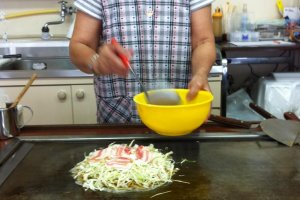Mitsu is the old port area of Matsuyama. Once just a small island, the land was gradually reclaimed until what was once the coast of the Seto Inland Sea became an inland river. It’s a fascinating area, with buildings dating back to the Edo, Meiji, Taisho and Showa periods. At first, Mitsu appears gritty and run-down. Spend a little time here however, and you’ll discover some fine historical buildings, and encounter people who offer a charming and unassuming welcome.
Mitsu also claims to be home to okonomi yaki, a pancake-like food whose name means literally “cooked as you like it”. Apparently it emerged in the early 20th century, corresponding to Japan’s Taisho period. Food was scarce and the government was trying to promote Western-style eating to produce people who were big like foreigners. Flour was readily available, which lent itself to pancakes. But Mitsu was both a fishing port where shrimp and squid were readily available, and a commercial port where soy beans were landed. There were also salt flats nearby, making Mitsu an ideal place for producing soy sauce. The ingredients for this new kind of food were all in place.
There are many okonomi yaki shops in Mitsu (in Japanese, shop also means restaurant, and it becomes a habit to call restaurants ‘shops’). One of the most obvious perhaps is Tomi (お好み焼き屋 とみ Okonomiyaki-ya Tomi), a tiny restaurant just across the river from the Iyotetsu Mitsu railway station. There’s a counter next to the hotplate and a couple of tables. The interior could be somebody’s kitchen. The elderly couple who run the place are very homely, so it feels a lot like sitting down to eat with your mum and dad. It takes at least 20 minutes to cook an okonomi yaki, which involves lots of ladling of batter, and frying of egg, and flipping the whole thing without it breaking up. It’s good entertainment, especially if you can manage a bit of Japanese, because the owners like to talk.
Okonomi yaki has a very homely taste—fine dining it isn’t. The okonomi yaki in Mitsu has a thin layer of batter on the bottom, then noodles, then cabbage, then meat and/or seafood, finished with omelette-like egg on top. Hitherto, whenever I’ve had okonomi with noodles, I’ve always had the egg-y ramen noodles. At Tomi, I was induced to try the thicker udon noodles and gosh! —Revelation! They were much better than the ramen noodles. I made a proper hash of cutting it up with the spatula I was given, so the lady of the house quickly did it for me.
The humble pancake that was supposed to turn Japanese into big Westerners now holds a place as an authentically Japanese food—if you believe the version of history I was earnestly fed in Mitsu.
































